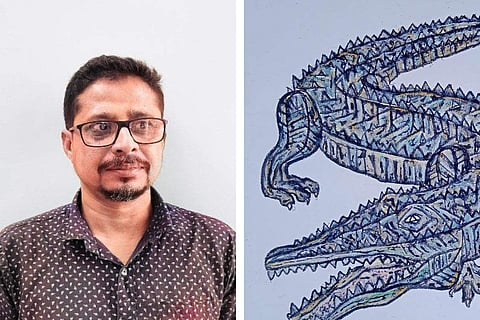
- LIFESTYLE
- FASHION
- FOOD
- ENTERTAINMENT
- EVENTS
- CULTURE
- VIDEOS
- WEB STORIES
- GALLERIES
- GADGETS
- CAR & BIKE
- SOCIETY
- TRAVEL
- NORTH EAST
- INDULGE CONNECT

What sets the works of artist Tridib Bera apart from the rest is the contrasting duality between his inspiration and the resultant artwork. For his ongoing exhibition, for instance, he has taken inspiration from animal bodies that have a soft structure and created metal sculptures that have a rugged texture. Titled Body Language, the exhibition features eight sculptures and four illustrations and is on display at Gallery Time & Space.
And the animals that feature in this series include bulls, cats, crocodiles, dogs, lions, monkeys, sheep and gorillas. If you look carefully, you will discover that most of them are quadrupeds. And this selection is not by chance. The artist, who hails from West Bengal and is now based in Bengaluru, explains, “I find the anatomy of quadrupeds way more interesting than of humans. They stand on four limbs, which means that they have a more stable equilibrium than bipeds; and that is what makes sketching animal anatomy more challenging, and at the same time, interesting.”
But what is the theme that he wants to explore across these sculptures and illustrations? Tridib elucidates, “I think, if we understand the nature of animals well, it also helps us to understand the nature of human beings. When I see a person who is loyal and would cross any limits for a loved one, they remind me of the nature of a dog. When I come across a person who is aggressive, they remind me of a lion. My little niece has a cat and every time I visit her, she keeps telling me how the cat does not bother about anyone but itself — she says she finds cats selfish.”
Being a former student of Kala Bhavan, the Shantiniketan school of aesthetics is prominent in Tridib’s works. “Artists like Rabindranath Tagore, Nandalal Bose and Ramkinkar Baij have a lot of influence on me. What I love in their work the most is the way they use lines. Being the most basic part of an illustration, lines are very important in Indian art, specially in folk art forms,” he tells us. Indian sculpture also influences him a lot, he further notes, specially the ones from the Gupta and the post-Gupta period.
Perhaps exposure to these is what developed his signature style in sculpting, which is reducing the mass of a sculpture while retaining its bulk. Even in his illustrations, one can notice a hollow, rough form. “I always draw my figures first in portrait and then from the front. Then, I used diagonal lines to connect the two. Through the use of these two dimensions, I try to convey the principle of duality in nature — good and evil, femininity and masculinity and most importantly, a journey outward and inward,” Tridib says.
The sculptures to be displayed are made by welding steel. One of the main reasons behind the use of this medium, according to the artist, is that steel has more longevity than iron, which can corrode due to rusting. The illustrations are done on paper, primarily using ink or oil pastels. The colour palette of the illustrations, too, primarily consists of black, white and metallic colours, apart from occasionally including muted hues like dark green.
Like most artists, Tridib derives inspiration from his surroundings. He lets us in on his childhood, “I was born in a remote village in West Bengal where taking art classes was a luxury.” However, that didn’t keep him away from being mesmerised with ordinary sightings, such as farmers cutting a stack of hay or the hollow structure of a Durga effigy floating away after immersion — which probably made him fall in love with the rugged texture of hay — a texture which finds expression repeatedly in his works.
While the artist is quite excited about this exhibition, his first one since the COVID-19 lockdowns, he is also one of those who believe in the cycle of continuous,“construction and destruction,” and do not get attached to their creations. In fact, he is already thinking of ideas for his next exhibitions. “I have plans to do a series called Mahishasuramardini (Destroyer of Mahishasura, Goddess Durga). Certain artworks, like the illustrations of lions that I have used in this series, will hopefully help me in creating pieces for the Mahishasuramardini series. There is another series that I am halfway through, which is a collection of metal sculptures of Jesus Christ. I also have plans to create a series based on my interpretation of the epic Mahabharata,” he says, signing off.
Till July 31. At Gallery Time & Space.
Email: prattusa@newindianexpress.com
Twitter: @MallikPrattusa